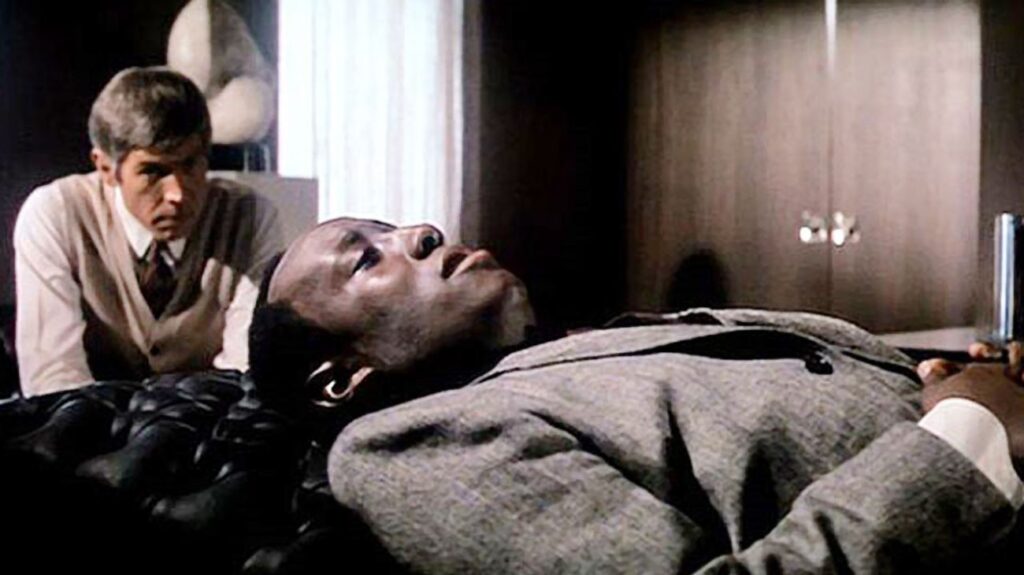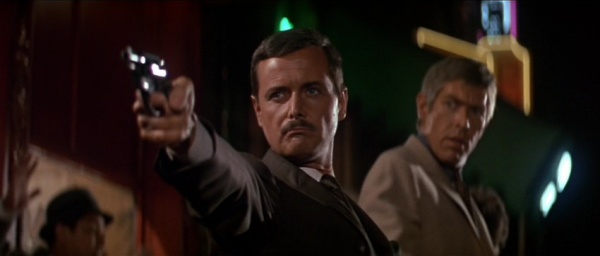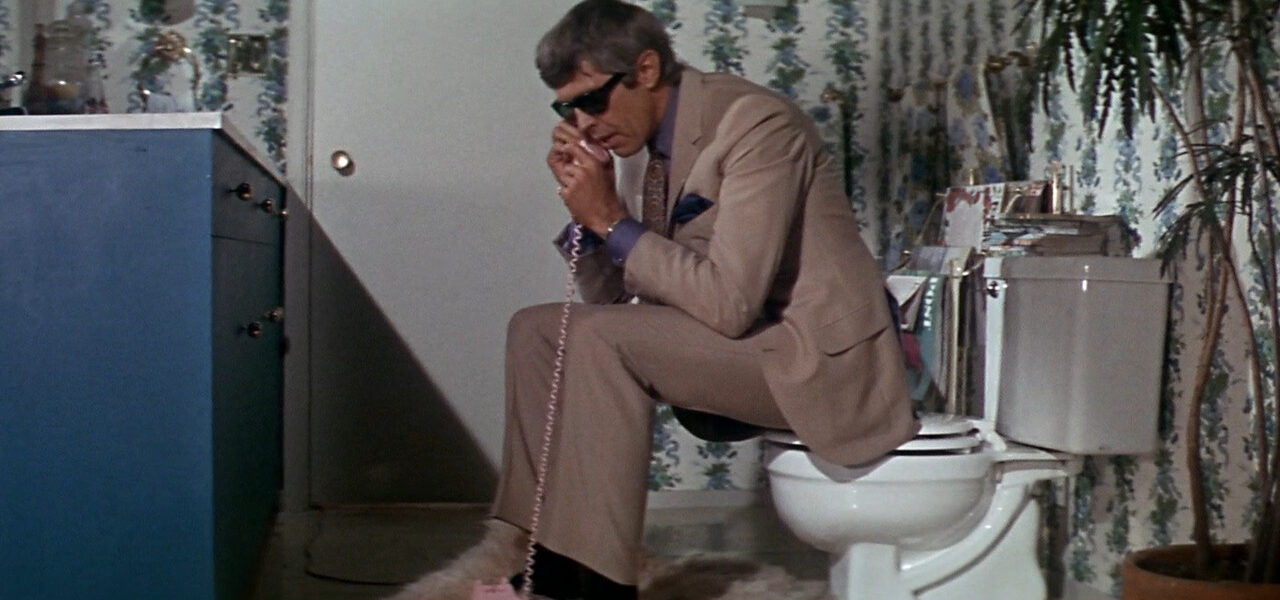The Sixties Stagger Mid-Swing In Era-Capping Film Satire
DIRECTOR: THEODORE J. FLICKER
STREET DATE: MARCH 12TH, 2024/KINO LORBER STUDIO CLASSICS

He’s hip, he’s happening, he’s “with-it”; he’s Dr. Sidney Schaefer, hi-fi loft resident of Greenwich Village and glass-tower Madison Avenue psychiatrist, and he’s about to land the plum assignment of personal analyst to the President of these United States. The emerging New Hollywood, under the aegis of recently appointed head of Paramount studios Robert Evans, is similarly about to take their first swing at the culture, four years after the assassination of President John F. Kennedy, and a few months before the twin assassinations of Robert F. Kennedy and Martin Luther King Jr., by directly naming the FBI and the CIA in a plot designed to anticipate the wildest imaginings of the most hardened conspiracy nut. Sorry, make that “FBR” and “CEA” in the legally-mandated disclaimer, re-edit, and redub, but even that doesn’t begin to approach the film’s larger target in the monopolistic and all-surveilling Bell Telephone. The goddamned Phone Company!
Or the all-consuming All American Family, for that matter. No,1967’s The President’s Analyst, remastered in 4K on a new Blu-ray from Kino Lorber, is more equal opportunity in its wider-ranging paranoia, ultimately suggesting that suspicion, distrust, and skepticism are the sanest psychological responses to a society that has become psychotically afraid and murderously self-sabotaging of itself. 57 years on, anticipating everything from Watergate to the fall of Communism to the rise of AI, the anxieties, hang-ups, and complexes of the highest office of the land have become our own, as contemporary audiences to the eternally viewing now continue to stagger past the point of no return.

That point, writer/director Theodore J. Flicker suggests, occurs just past a Zapruder-blur on the American flag as Afro-wigged CEA agent Don Masters (Godfrey Cambridge), also wearing a sleeveless “Dizzy Gillespie For President” sweatshirt and pushing a trolley-rack of shag-haired coats down Fifth Avenue, momentarily pauses in his toil to jam a knife into the heart of an Albanian double-agent under the cover of broad daylight. Not so shocking for its depiction of a state-sanctioned murder, old hat by this time in Cold War politics, but more for the exciting and even healthy release of hostility Agent Masters describes later to Dr. Schaefer (James Coburn) during their therapy session, the continual albeit insurmountable revenge of a Black man living in White America; which in turn signals to Masters’ superiors Schafer’s suitability for medical confidante to state secrets at the highest level of security clearance. After further oily vetting from don-nish, tweed-wearing CEA head Ethan Allen Cockett (Eduard Franz), and grudging approval from gruff, diminutive FBR chief Henry Lux (Walter Burke), Schaefer soon finds himself transported by long underground tunnel beneath the White House to the outer foyer of the President’s personal chambers.
Your tax dollars at work! But the flashing red light signaling the powerful man’s “needs” quickly becomes wearing for the good doctor, interrupting sleep, the call of nature, and lovemaking alike, and the seed of paranoia begins to grow, extending itself through his dreams and ultimately suspicion of his girlfriend Nan Butler (Joan Delaney). Seizing opportunity for escape with seemingly normal New Jersey nuclear family Wynn, Jeff, and young Bing Quantrill (William Daniels, Joan Darling, Sheldon Collins) during a guided White House tour, the President’s Analyst leads the shadowy forces of world governance, eager to access his patient’s powerful psyche, on a grand tour of his own, first following acid rock group Clear Light (themselves) and “Eve of Destruction” scribe Barry McGuire (himself), led soft-focus hand-in-hand to a paradisal field-tryst with comely groupie Snow White (Jill Banner), and subsequently and psychedelically shanghaied aboard a Canadian vessel called “Mata Hari” (John Wayne’s naval-salvage cruiser “Wild Goose”).
Caught up at this time by “friendly” agents protecting Schaefer from the murderous FBR, namely the proto-Glasnost partners across the Iron Curtain, Agent Masters, and his opposite number in the Russian secret service, Kropotkin (Severn Darden) – following Schafer throughout and successively “eliminating” their rival spies from all parts of the globe – the trio eventually turn their attention to the true villains of the piece: all-watching, all-knowing, all-growing. The acronym “TPC” soon becomes clear, as their fiendish plan to overturn democracy and enslave humanity in a vast, interconnected web of instant communication is revealed.

Which just happens to be the world we now live in. The President’s Analyst was first sold on its title, a nodding acquaintance between experimental theater director Theodore J. Flicker, with his background in improvisational comedy containing social and political dimensions, and star James Coburn, fresh off the cheeky spy parodies Our Man Flint (1966) and In Like Flint (1967), yielding a deal between Coborn’s production company Panpiper and Old Guard Hollywood studio Paramount, smack dab in the middle of a regime-change, within a week of rapid negotiation. Widescreen camerawork by William A. Fraker and 007-level production design from frequent Hitchcock collaborator Hal Pereira serve to imbue this inherently transitional film with a background sheen that foregrounds the at times unpredictable detours and unexpected dimensions of the storyline and characters.
Playing like some comic nightmare extension of Coburn’s parodic and cartoonish turn as impossibly suave superspy Derek Flint, The President’s Analyst takes a rapid turn towards black farce, with its sharper jabs at race, international, and ultimately interpersonal relations discomfitingly portending the baseline of governmental distrust and social paranoia soon to become familiar in political thrillers such as The Conversation (1974), The Parallax View (ibid.), Three Days of the Condor (1975), and ultimately All the President’s Men (1976). The last of course being entirely drawn from as opposed to being merely inspired by real events, the bright and Pop-py surface of this retrospectively unmistakable precursor almost intuitively illuminating darker undercurrents soon to surface at a rate too rapid and dizzying to record them.

Seeming to capture The Swinging Sixties just as it begins to stagger mid-Swing, the plague-like litany of events immediately following the so-called Summer of Love – escalation in Vietnam, LBJ’s decision not to run for reelection, riots at Chicago’s Democratic National Convention, assassinations of Kennedy and King, Nixon’s election – might very well be viewed as direct sequel through the kaleidoscopic lens of The President’s Analyst’s final image of surveillance and recording. “Through the looking glass” is how audio commentator Tim Lucas puts it, Schaefer’s mid-film pursuit and exit from the famed Cafe Wha? directly into a hippie Volkswagen potentially liberating for some viewers, but still carrying the explosive contradictions of a sharply divided America soon to unleash a darker and dingier aesthetic on the subsequent decade of films.
Kino Lorber’s new Blu-ray is as mentioned remastered from a 4K scan of Paramount’s original camera negative, the upgraded visuals a clear advance on previously muddled and murkier DVD versions. Also restoring the Clear Light/Barry McGuire songs missing from previous TV broadcast versions, fitting in nicely with score composer Lalo Schifrin’s flighty flutes and French horns, the soundtrack itself remains a gas, gas, gas, and the overall effect is appropriately as much a trip as the illicit blue substance lacing the drinks at the psychedelic musical haunt; where, incidentally, Coburn as Schaefer has a chance to show off some of his real-life gong skills. Also also including not one but two audio commentary tracks, the latter as again mentioned from film historian and Man With Kaleidoscope Eyes (2022) author Tim Lucas, recorded in 2020, and the former from film historian and writer Julie Kirgo and writer/filmmaker Peter Hankoff, both tracks are highly appreciative of this often overlooked movie, and between them offer historical context and cogent analysis of The President’s Analyst’s unique and prescient place in Hollywood’s more critical engagement with the broader culture.
Finally, does a cut of The President’s Analyst exist in which writer/director Flicker, who subsequently worked on only a handful of films, directly named the CIA and FBI in his conspiratorial plot? Lucas, along with Kirgo and Hankoff, dispel the many myths and exaggerations that have arisen regarding, in its most sinister iteration, direct governmental censorship, including the more personal reasons Flicker largely retired to an artist’s colony in Santa Fe, New Mexico after its release. But still, viewed today, The President’s Analyst remains astonishing for being a mainstream film, released by a major studio, that, made at its particular historical moment, dared to pose some fairly provocative questions about where as a country we’ve been, where we are “now”, and where we’re ultimately heading.
Images in this review are used only as a visual reference to the film and do not reflect the image quality of Kino Lorber’s special edition Blu-ray release of The President’s Analyst (1967).


